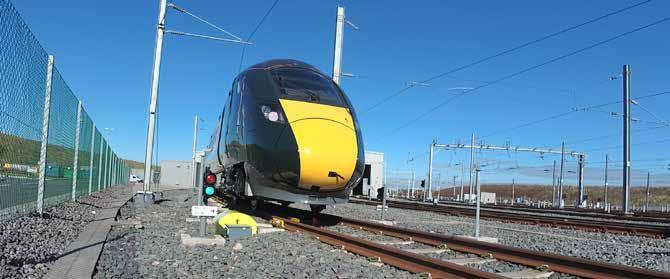54
LIGHT RAIL/METRO
An CLIVE KESSELL
l i a R t h g i L f o
MALCOLM DOBELL
T
he term light rail covers many facets. To many, it means a tram system or a network such as Docklands Light Railway, but in fact it covers much more and will even impact on traditional heavy rail.
To bring out some notable new concepts and to examine the ongoing expansion of existing systems, the Railway Industry Association (RIA) staged a series of short online sessions over a five-day period in mid-December 2020, during which various experts examined some innovative opportunities that may well come to fruition in the next few years. It proved immensely interesting...
Tram Train Many readers will be familiar with the tram-train experiment between Sheffield Cathedral and Rotherham Parkgate, introduced in October 2018. Running firstly on the Sheffield Super Tram system, it then connects on to Network Rail infrastructure before diverging on to a short section of dedicated track into Rotherham. The vehicles therefore have to be both trams and trains during their five-mile journey. Seven vehicles were purchased from Stadler, said Simon Coulthard from the Network Rail Light Rail Development group, having both a 750V DC and 25kV AC capability from overhead lines. However, for this project, only the 750V DC power supply is used as Network Rail has electrified its part of the route at this voltage.
Fully accessible boarding with low-level platform access was part of the specification. Since opening, 1.6 million journeys have been made, 96 per cent of services arrived within five minutes of right time, the fleet has amassed 903,000km of running and 100 per cent passenger satisfaction recorded. Differences between a tram train and a tram are: 1. It has to be equipped with equipment to obey the Network Rail signalling systems, including AWS (Automatic Warning System) and TPWS (Train Protection and Warning System); 2. Crashworthiness has to be uprated; 3. Wheel profiles that are different from main line standards have to be catered for, with a raised check rail being a possibility to prevent derailments on points and crossings; 4. Clearances have to conform, as heavy rail freight trains use part of the same route. Although the trial is officially ended, the service continues with Local Authority support. It is considered a pipeline for the future and talks are continuing with other operators around the UK including Manchester and the West Midlands.
New Technologies and Innovation Light rail abounds with new ideas. James Hammett, the managing director of UK Tram, and Alex Dodds from Network Rail produced a shopping list of things that are being considered and worked on for light rail systems, including where these interface to heavy rail. Their list included: Âť Catenary-free operation, building on experience with the CAF trams now operating on the West Midlands Metro;
Rail Engineer | Issue 186 | September/October 2020













